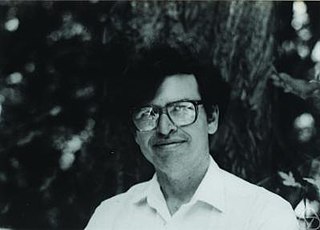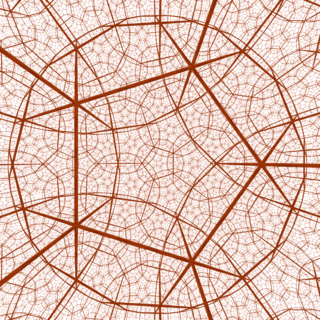Related Research Articles

William Paul Thurston was an American mathematician. He was a pioneer in the field of low-dimensional topology and was awarded the Fields Medal in 1982 for his contributions to the study of 3-manifolds.

In knot theory, a figure-eight knot is the unique knot with a crossing number of four. This makes it the knot with the third-smallest possible crossing number, after the unknot and the trefoil knot. The figure-eight knot is a prime knot.
In mathematics, Thurston's geometrization conjecture states that each of certain three-dimensional topological spaces has a unique geometric structure that can be associated with it. It is an analogue of the uniformization theorem for two-dimensional surfaces, which states that every simply connected Riemann surface can be given one of three geometries . In three dimensions, it is not always possible to assign a single geometry to a whole topological space. Instead, the geometrization conjecture states that every closed 3-manifold can be decomposed in a canonical way into pieces that each have one of eight types of geometric structure. The conjecture was proposed by William Thurston (1982), and implies several other conjectures, such as the Poincaré conjecture and Thurston's elliptization conjecture.
In mathematics, the JSJ decomposition, also known as the toral decomposition, is a topological construct given by the following theorem:
In mathematics, a Haken manifold is a compact, P²-irreducible 3-manifold that is sufficiently large, meaning that it contains a properly embedded two-sided incompressible surface. Sometimes one considers only orientable Haken manifolds, in which case a Haken manifold is a compact, orientable, irreducible 3-manifold that contains an orientable, incompressible surface.

In mathematics, low-dimensional topology is the branch of topology that studies manifolds, or more generally topological spaces, of four or fewer dimensions. Representative topics are the structure theory of 3-manifolds and 4-manifolds, knot theory, and braid groups. This can be regarded as a part of geometric topology. It may also be used to refer to the study of topological spaces of dimension 1, though this is more typically considered part of continuum theory.

In mathematics, a 3-manifold is a topological space that locally looks like a three-dimensional Euclidean space. A 3-manifold can be thought of as a possible shape of the universe. Just as a sphere looks like a plane to a small enough observer, all 3-manifolds look like our universe does to a small enough observer. This is made more precise in the definition below.
In mathematics, more precisely in topology and differential geometry, a hyperbolic 3-manifold is a manifold of dimension 3 equipped with a hyperbolic metric, that is a Riemannian metric which has all its sectional curvatures equal to −1. It is generally required that this metric be also complete: in this case the manifold can be realised as a quotient of the 3-dimensional hyperbolic space by a discrete group of isometries.
In mathematics, an atoroidal 3-manifold is one that does not contain an essential torus. There are two major variations in this terminology: an essential torus may be defined geometrically, as an embedded, non-boundary parallel, incompressible torus, or it may be defined algebraically, as a subgroup of its fundamental group that is not conjugate to a peripheral subgroup. The terminology is not standardized, and different authors require atoroidal 3-manifolds to satisfy certain additional restrictions. For instance:

In mathematics, a hyperbolic manifold is a space where every point looks locally like hyperbolic space of some dimension. They are especially studied in dimensions 2 and 3, where they are called hyperbolic surfaces and hyperbolic 3-manifolds, respectively. In these dimensions, they are important because most manifolds can be made into a hyperbolic manifold by a homeomorphism. This is a consequence of the uniformization theorem for surfaces and the geometrization theorem for 3-manifolds proved by Perelman.
In mathematics, Thurston's classification theorem characterizes homeomorphisms of a compact orientable surface. William Thurston's theorem completes the work initiated by Jakob Nielsen (1944).
In the mathematical subfield of 3-manifolds, the virtually fibered conjecture, formulated by American mathematician William Thurston, states that every closed, irreducible, atoroidal 3-manifold with infinite fundamental group has a finite cover which is a surface bundle over the circle.
In topology, an area of mathematics, the virtually Haken conjecture states that every compact, orientable, irreducible three-dimensional manifold with infinite fundamental group is virtually Haken. That is, it has a finite cover that is a Haken manifold.
In mathematics, the 2π theorem of Gromov and Thurston states a sufficient condition for Dehn filling on a cusped hyperbolic 3-manifold to result in a negatively curved 3-manifold.
James W. Cannon is an American mathematician working in the areas of low-dimensional topology and geometric group theory. He was an Orson Pratt Professor of Mathematics at Brigham Young University.
In hyperbolic geometry, the ending lamination theorem, originally conjectured by William Thurston (1982), states that hyperbolic 3-manifolds with finitely generated fundamental groups are determined by their topology together with certain "end invariants", which are geodesic laminations on some surfaces in the boundary of the manifold.
In hyperbolic geometry, Thurston's double limit theorem gives condition for a sequence of quasi-Fuchsian groups to have a convergent subsequence. It was introduced in Thurston and is a major step in Thurston's proof of the hyperbolization theorem for the case of manifolds that fiber over the circle.
In geometric group theory, the Rips machine is a method of studying the action of groups on R-trees. It was introduced in unpublished work of Eliyahu Rips in about 1991.
Albert Marden is an American mathematician, specializing in complex analysis and hyperbolic geometry.
References
- Kapovich, Michael (2009) [2001], Hyperbolic manifolds and discrete groups, Modern Birkhäuser Classics, Boston, MA: Birkhäuser Boston, doi:10.1007/978-0-8176-4913-5, ISBN 978-0-8176-4912-8, MR 1792613
- McMullen, C. (1990), "Iteration on Teichmüller space", Inventiones Mathematicae , 99 (2): 425–454, Bibcode:1990InMat..99..425M, CiteSeerX 10.1.1.39.2226 , doi:10.1007/BF01234427, MR 1031909, S2CID 122626150
- Morgan, John W. (1984), "On Thurston's uniformization theorem for three-dimensional manifolds", in Morgan, John W.; Bass, Hyman (eds.), The Smith conjecture (New York, 1979), Pure Appl. Math., vol. 112, Boston, MA: Academic Press, pp. 37–125, ISBN 978-0-12-506980-9, MR 0758464
- Otal, Jean-Pierre (1996), "Le théorème d'hyperbolisation pour les variétés fibrées de dimension 3", Astérisque (235), MR 1402300 Translated into English as Otal, Jean-Pierre (2001) [1996], Kay, Leslie D. (ed.), The hyperbolization theorem for fibered 3-manifolds, SMF/AMS Texts and Monographs, vol. 7, Providence, R.I.: American Mathematical Society, ISBN 978-0-8218-2153-4, MR 1855976
- Otal, Jean-Pierre (1998), "Thurston's hyperbolization of Haken manifolds", in Hsiung, C.-C.; Yau, Shing-Tung (eds.), Surveys in differential geometry, Vol. III (Cambridge, MA, 1996), Int. Press, Boston, MA, pp. 77–194, ISBN 978-1-57146-067-7, MR 1677888, archived from the original on 2011-01-06
- Sullivan, Dennis (1981), "Travaux de Thurston sur les groupes quasi-fuchsiens et les variétés hyperboliques de dimension 3 fibrées sur S1", Bourbaki Seminar, Vol. 1979/80, Lecture Notes in Math., vol. 842, Berlin, New York: Springer-Verlag, pp. 196–214, doi: 10.1007/BFb0089935 , ISBN 978-3-540-10292-2, MR 0636524
- Thurston, William P. (1982), "Three-dimensional manifolds, Kleinian groups and hyperbolic geometry", Bulletin of the American Mathematical Society, New Series, 6 (3): 357–381, doi: 10.1090/S0273-0979-1982-15003-0 , MR 0648524 This gives the original statement of the conjecture.
- Thurston, William P. (1986), "Hyperbolic structures on 3-manifolds. I. Deformation of acylindrical manifolds", Annals of Mathematics , Second Series, 124 (2): 203–246, arXiv: math/9801019 , doi:10.2307/1971277, JSTOR 1971277, MR 0855294, S2CID 14114726
- Thurston, William P. (1994), "On proof and progress in mathematics", Bulletin of the American Mathematical Society, New Series, 30 (2): 161–177, arXiv: math/9404236 , doi:10.1090/S0273-0979-1994-00502-6, MR 1249357
- Thurston, William P. (1998a) [1986], Hyperbolic Structures on 3-manifolds, II: Surface groups and 3-manifolds which fiber over the circle, arXiv: math/9801045 , Bibcode:1998math......1045T
- Thurston, William P. (1998b) [1986], Hyperbolic Structures on 3-manifolds, III: Deformations of 3-manifolds with incompressible boundary, arXiv: math/9801058 , Bibcode:1998math......1058T
- Wall, C. T. C. (1984), "On the work of W. Thurston", in Ciesielski, Zbigniew; Olech, Czesław (eds.), Proceedings of the International Congress of Mathematicians, Vol. 1 (Warsaw, 1983), Warszawa: PWN, pp. 11–14, ISBN 978-83-01-05523-3, MR 0804672